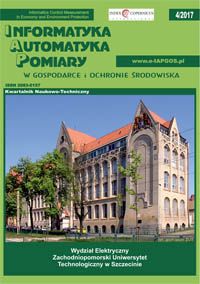BOOST QUASI-RESONANT CONVERTERS FOR PHOTOVOLTAIC SYSTEM
Article Sidebar
Open full text
Issue Vol. 7 No. 4 (2017)
-
SELECTED PROBLEMS OF EVALUATION AND CLASSIFICATION OF HISTORICAL BUILDINGS USING ROUGH SETS
Krzysztof Czajkowski5-10
-
LABORATORY STAND FOR SMALL WIND TURBINE SIMULATION
Wojciech Matelski, Eugeniusz Łowiec, Stanisław Abramik11-14
-
DEVELOPMENT OF AN AUTOMATED DIAGNOSTICS AND CONTROL SYSTEM FOR BIOGAS COMBUSTION PROCESSES
Oxana Zhirnova15-19
-
SUPPLY CHAIN RISK MANAGEMENT BY MONTE CARLO METHOD
Tomasz Rymarczyk, Grzegorz Kłosowski20-23
-
THE USE OF PETRI NETS IN DECISION SUPPORT SYSTEMS BASED ON INTELLIGENT MULTIPLY SOURCE DATA ANALYSIS
Tomasz Rymarczyk, Grzegorz Kłosowski, Tomasz Cieplak24-27
-
APPLICABILITY ANALYSIS OF REST AND SOAP WEB SERVICES
Tomasz Zientarski, Marek Miłosz, Marek Kamiński, Maciej Kołodziej28-31
-
A REVIEW OF CONTROL METHODS OF WIND TURBINE SYSTEMS WITH PERMANENT MAGNET SYNCHRONOUS GENERATOR
Piotr Gajewski32-37
-
DIRECT TORQUE CONTROL OF MULTI-PHASE INDUCTION MOTOR WITH FUZZY LOGIC SPEED CONTROLLER
Jacek Listwan38-43
-
IMAGE COMPLETION WITH LOW-RANK MODEL APPROXIMATION METHODS
Tomasz Sadowski, Rafał Zdunek44-48
-
APPROXIMATION OF ELECTRIC PROPERTIES OF PERIODIC LAYERED COMPOSITE MATERIALS
Adam Steckiewicz, Bogusław Butryło49-52
-
BOOST QUASI-RESONANT CONVERTERS FOR PHOTOVOLTAIC SYSTEM
Michał Harasimczuk53-56
-
RESEARCH OF FLOW AROUND SELECTED SENSORS PROFILES FOR METROLOGY FLOWS
Piotr Zgolak57-61
-
MAXIMUM SUBARRAY PROBLEM OPTIMIZATION FOR SPECIFIC DATA
Tomasz Rojek62-65
-
ANALYSIS OF POWER LOSS IN THE LOW-SPEED PNEUMATIC ENGINE
Adam Ilnicki, Mariusz Rząsa66-69
-
APPLICATION OF FUZZY COGNITIVE MAP TO PREDICT OF EFFECTIVENESS OF BIKE SHARING SYSTEMS
Aleksander Jastriebow, Łukasz Kubuś, Katarzyna Poczęta70-73
-
FUZZY COGNITIVE MAP AS AN INTELLIGENT RECOMMENDER SYSTEM OF WEBSITE RESOURCES
Aleksander Jastriebow, Łukasz Kubuś, Katarzyna Poczęta74-78
-
MODELING OF THE ARTIFICIAL BLOOD CHAMBER AND THE MICROPUMPS PULSATILE DRIVE FOR BLOOD TRANSFUSION
Sebastian Bartel79-81
-
CONTROL A SMALL WIND TURBINE WITH ASYNCHRONOUS GENERATOR
Kamil Możdżyński, Tomasz Gajowik, Krzysztof Rafał, Mariusz Malinowski82-87
-
MECHANICAL PROPERTIES OF SELECTED EPOXY ADHESIVES
Izabela Miturska, Anna Rudawska88-91
-
POLYNOMIAL APPROXIMATION FOR T WAVE PARAMETER RECOGNITION IN ECG PROCESSING
Marcin Maciejewski92-95
-
THE IMPACT OF WINDOW FUNCTION ON IDENTIFICATION OF SPEAKER EMOTIONAL STATE
Paweł Powroźnik, Dariusz Czerwiński96-100
-
USE OF MULTICRITERIAL OPTIMIZATION IN FURNITURE MANUFACTURING PROCESS
Grzegorz Kłosowski, Edward Kozłowski101-106
-
MODEL OF DYNAMIC ELEVATOR CONTROL SYSTEM USING CENTRAL APPLICATION SERVER
Łukasz Furgała, Krzysztof Kolano, Włodzimierz Mosorow107-112
Archives
-
Vol. 9 No. 4
2019-12-16 20
-
Vol. 9 No. 3
2019-09-26 20
-
Vol. 9 No. 2
2019-06-21 16
-
Vol. 9 No. 1
2019-03-03 13
-
Vol. 8 No. 4
2018-12-16 16
-
Vol. 8 No. 3
2018-09-25 16
-
Vol. 8 No. 2
2018-05-30 18
-
Vol. 8 No. 1
2018-02-28 18
-
Vol. 7 No. 4
2017-12-21 23
-
Vol. 7 No. 3
2017-09-30 24
-
Vol. 7 No. 2
2017-06-30 27
-
Vol. 7 No. 1
2017-03-03 33
-
Vol. 6 No. 4
2016-12-22 16
-
Vol. 6 No. 3
2016-08-08 18
-
Vol. 6 No. 2
2016-05-10 16
-
Vol. 6 No. 1
2016-02-04 16
-
Vol. 5 No. 4
2015-10-28 19
-
Vol. 5 No. 3
2015-09-02 17
-
Vol. 5 No. 2
2015-06-30 15
-
Vol. 5 No. 1
2015-03-31 18
Main Article Content
DOI
Authors
m.harasimczuk@doktoranci.pb.edu.pl
Abstract
This paper presents PWM quasi-resonant boost converter for photovoltaic systems. The use of a resonant circuit enabled switching transistor in zero current (ZCS). Continuous conduction mode (CCM) with current control has been achieved. This allows to implement MPPT algorithm. The use of transistor switching resonant capacity allowed source (PV) current ripple with constant frequency and high efficiency in different load current. In the article has been discussed principle of operation the converter. Simulation converter in PSpice have been presented.
Keywords:
References
Bellini A., Bifaretti S.: A quasi-resonant ZCS Boost DC-DC Converter for Photovoltaic Applications. International Symposium on Industrial Electronics IEEE 2007, 815–820.
Citko T., Tunia H., Winiarski B.: Układy rezonansowe w energoelektronice. Białystok, 144–148.
Hua G., Lee F. C.: Soft-switching techniques in PWM converters. Transactions on Industrial Electronics IEEE 1995, 595–603.
Lee F. C.: High-frequency quasi-resonant converter technologies. Proceedings of the IEEE 1988, 377–390.
Yeong-Chau K., Tsorng-Juu L., Jiann-Fuh C.: Novel maximum-power-point-tracking controller for photovoltaic energy conversion system. Transactions on Industrial Electronics IEEE 2001, 594–601.
Article Details
Abstract views: 303
License

This work is licensed under a Creative Commons Attribution-ShareAlike 4.0 International License.






